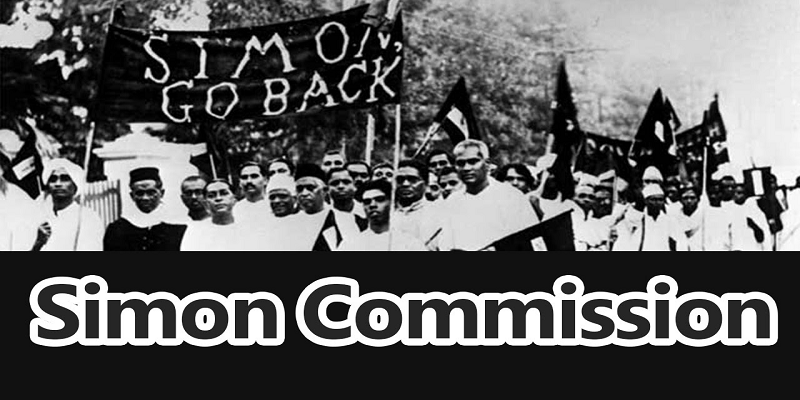A Turning Point in India's Fight for Independence by Simon Commission
The Simon Commission, officially known as the Indian Statutory Commission, was a significant event in India's struggle for independence. It played a crucial role in shaping the political landscape and fostering a sense of unity among Indians against British colonial rule. The Commission, named after its chairman Sir John Simon, was appointed in 1927 to assess the constitutional progress in India and recommend reforms. However, it faced vehement opposition from various sections of Indian society, leading to a turning point in the fight for self-determination.
Background:
In the aftermath of World War I, the demand for self-rule in India gained momentum. The Montagu-Chelmsford Reforms of 1919 introduced limited self-government, but they fell short of Indian expectations. As discontent grew, the need for constitutional reforms became evident. In this context, the British government appointed the Simon Commission to review the existing constitutional arrangements and suggest ways to move forward.
Composition of the Simon Commission:
The Simon Commission, formed in 1927, consisted entirely of British members, with no Indian representation. This omission deeply offended the Indian political leadership, as it was seen as a denial of the right of Indians to determine their own future. The exclusion of Indians from the Commission was a clear manifestation of the paternalistic and imperialistic mindset prevailing within the British administration.
Reaction in India:
The announcement of the Simon Commission triggered widespread protests and opposition in India. All major political parties, including the Indian National Congress, the All India Muslim League, and the Sikh Akali Dal, boycotted the Commission. The absence of Indian members and the belief that the Commission was not genuinely interested in understanding Indian aspirations fueled the resentment.
Lala Lajpat Rai's Sacrifice:
The most tragic incident during the Simon Commission protests occurred in Lahore in 1928. Lala Lajpat Rai, a prominent leader, led a peaceful protest against the Commission. The police responded with baton charges, and Rai sustained injuries. He succumbed to these injuries, and his death galvanized the Indian freedom movement. Bhagat Singh, Sukhdev, and Rajguru later avenged Rai's death by targeting the police officer responsible, James A. Scott.
The Nehru Report:
In response to the Simon Commission, the Indian National Congress appointed a committee under Motilal Nehru to draft a constitution for India. The Nehru Report, presented in 1928, proposed dominion status for India within the British Commonwealth and a federal structure. However, it was met with resistance from the Muslim League and other minority communities, leading to the demand for separate electorates.
Demand for Dominion Status:
The Simon Commission faced criticism not only for its composition but also for its failure to recommend complete self-rule for India. The demand for dominion status, as proposed by the Nehru Report, gained momentum. Leaders like Jawaharlal Nehru and Subhas Chandra Bose became vocal advocates of full independence, rejecting any compromises short of complete sovereignty.
Congress-Muslim League Rift:
The differing visions of the Congress and the Muslim League regarding India's future aggravated tensions. While the Congress aimed for a united, independent India, the Muslim League, led by Muhammad Ali Jinnah, began advocating the idea of a separate nation for Muslims. This divergence laid the groundwork for the eventual partition of India in 1947.
The Communal Award:
In 1932, the British government, under Prime Minister Ramsay MacDonald, announced the Communal Award, which further deepened communal divisions by granting separate electorates to various religious and social groups. This move was an attempt to secure the support of different communities, but it fueled communalism and hindered the cause of a united India.
Round Table Conferences:
To address the constitutional impasse, a series of Round Table Conferences were held between 1930 and 1932. These conferences aimed to bring together various political groups to find a consensus on India's future. However, the major parties, including the Congress and the Muslim League, remained at odds, and the conferences failed to produce a viable solution.
Legacy and Impact:
The Simon Commission and its aftermath had a profound impact on India's struggle for independence. It solidified the unity among Indians against colonial rule, leading to the formation of a broad-based nationalist front. The sacrifices made during the protests, such as the death of Lala Lajpat Rai and the subsequent actions of Bhagat Singh, became symbols of resistance.
While the Simon Commission itself did not result in immediate constitutional changes, it set the stage for future developments. The demand for complete independence gained momentum, and the political landscape continued to evolve, eventually leading to India's independence in 1947.
The Simon Commission was a pivotal moment in India's quest for self-determination. The protests against its composition and the subsequent events marked a shift in the nature of the struggle, emphasizing the need for complete independence rather than incremental reforms. The Commission and its aftermath played a crucial role in shaping the course of Indian history and laying the groundwork for the establishment of an independent and democratic India.

